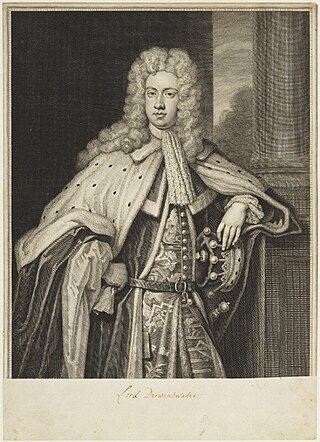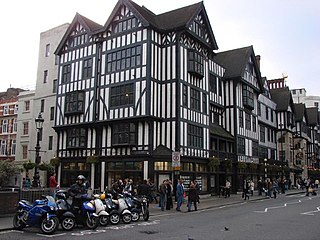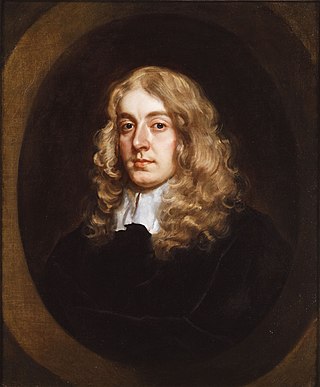Related Research Articles

Earl of Lichfield is a title that has been created three times, twice in the Peerage of England and once in the Peerage of the United Kingdom (1831). The third creation is extant and is held by a member of the Anson family.

Viscount Bolingbroke is a current title in the Peerage of Great Britain created in 1712 for Henry St John. He was simultaneously made Baron St John, of Lydiard Tregoze in the County of Wilts. Since 1751, the titles are merged with the titles of Viscount St John and Baron St John in the same peerage.

Earl of Onslow, of Onslow in the County of Shropshire and of Clandon Park in the County of Surrey is a title in the Peerage of the United Kingdom. It was created in 1801 for George Onslow, 4th Baron Onslow.

Earl of Romney is a title that has been created twice.

Baron Bicester, of Tusmore in the County of Oxford, is a title in the Peerage of the United Kingdom. It was created on 29 June 1938 for the banker Vivian Smith. As of 2018 the title is held by his great-grandson, the fifth Baron, who succeeded his first cousin once removed in 2016.

Earl of Derwentwater was a title in the Peerage of England. It was created in 1688 for Sir Francis Radclyffe, 3rd Baronet. He was made Baron Tyndale, of Tyndale in the County of Northumberland, and Viscount Radclyffe and Langley at the same time, also in the Peerage of England. He was succeeded by his son, the second Earl, who married Lady Mary Tudor, daughter of Charles II by his mistress Moll Davis.

Great Marlborough Street is a thoroughfare in Soho, Central London. It runs east of Regent Street past Carnaby Street towards Noel Street.
This is a list of people who have served as Custos Rotulorum of Denbighshire.

Viscount Scudamore was a title in the Peerage of Ireland held by three generations of the Scudamore family. It was created on 1 July 1628 for the diplomat and politician Sir John Scudamore, 1st Baronet. He had already been created a Baronet, of Holme Lacy in the County of Hereford, in the Baronetage of England on 1 June 1620, and was made Baron Dromore at the same time as he was granted the viscountcy, also in the Peerage of Ireland. Scudamore was the son of Sir James Scudamore and the grandson of Sir John Scudamore. Lord Scudamore was succeeded by his grandson, the second Viscount. He represented Hereford and Herefordshire in Parliament. On his death the titles passed to his son, the third Viscount. He was also Member of Parliament for Hereford and Herefordshire. The titles became extinct on his death in 1716.

There have been three baronetcies created for persons with the surname Burdett, two in the Baronetage of England and one in the Baronetage of Ireland. As of 2008, two of the creations are extant while one is dormant.

Sir Matthew White Ridley, 2nd Baronet, was a Northumbrian landowner and politician who sat in the House of Commons between 1768 and 1812.
Prince Hoare was an English sculptor. "Prince" in this instance was a given name, not a royal title.
Events from the year 1665 in England.

There have been three baronetcies created for persons with the surname Carew, two in the Baronetage of England prior to 1707, one in the Baronetage of Great Britain.

Sir Thomas Gooch, 2nd Baronet (1674–1754) was an English bishop.

Sir Hector Maclean, 5th Baronet of Morvern was the 21st Clan Chief of Clan Maclean from 1716 to 1750. He was raised to the Jacobite Peerage of Scotland as Lord Maclean on 17 December 1716, a title to pass on his male heirs.

The Eyles, later Eyles-Stiles Baronetcy, of London, was a title in the Baronetage of Great Britain. It was created on 1 December 1714 for the merchant and director of the Honourable East India Company, Francis Eyles. The second baronet was Lord Mayor of London from 1726 to 1727. He married Mary, daughter of Joseph Haskins Stiles of Moor Park, Rickmansworth, and their son, the third baronet, assumed the additional surname of Stiles. The title became extinct on the death of the fourth baronet in 1768.

The D'Aeth Baronetcy, of Knowlton in the County of Kent, was a title in the Baronetage of Great Britain.

The Morland Baronetcy, of Sulhamstead Banister in the County of Berkshire, was a title in the Baronetage of England. It was created on 18 July 1660 for the academic, diplomat, spy, inventor, and mathematician Samuel Morland. The title became extinct on the death of the second Baronet in 1716.

Sir Francis Eyles, 1st Baronet was an English merchant who was Governor of the Bank of England and a baronet in the Baronetage of Great Britain.